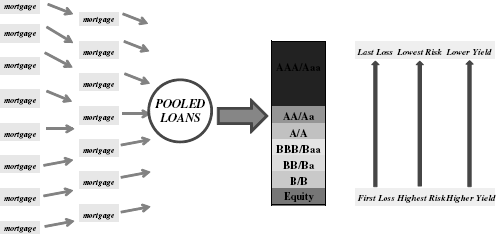Credit Enhancement
Structured finance produces a capital structure of prioritized claims known as tranches (see Figure 20.2) against the underlying pool of collateral. If constructed correctly, the CDO will provide credit enhancement for all tranches in the capital structure except for the first loss tranche (also called the equity tranche—the SPV generally retains ownership of these bonds). We now show how this works.
Figure 20.2 Structured Credit: Collateralized Mortgage Obligations

The tranches are prioritized in how they absorb losses from the underlying portfolio. Senior tranches absorb losses only after the junior claims have been exhausted, which allows senior tranches to achieve credit ratings that are higher than the average rating of the underlying pool. The degree of protection provided by junior tranches is known as overcollateralization, and it plays an important role in determining the credit rating of more senior tranches.
In its simplest form, the process of credit enhancement can best be understood by considering two securities (mortgages), each of which pays nothing upon default but one dollar otherwise (Coval et al. 2009). Both securities have the same probability of default. Suppose we combine these two securities into a $2 pool and issue two tranches against the pool. The junior tranche absorbs the first dollar loss and pays $1 in the event that neither mortgage ...
Get Investment Theory and Risk Management, + Website now with the O’Reilly learning platform.
O’Reilly members experience books, live events, courses curated by job role, and more from O’Reilly and nearly 200 top publishers.

